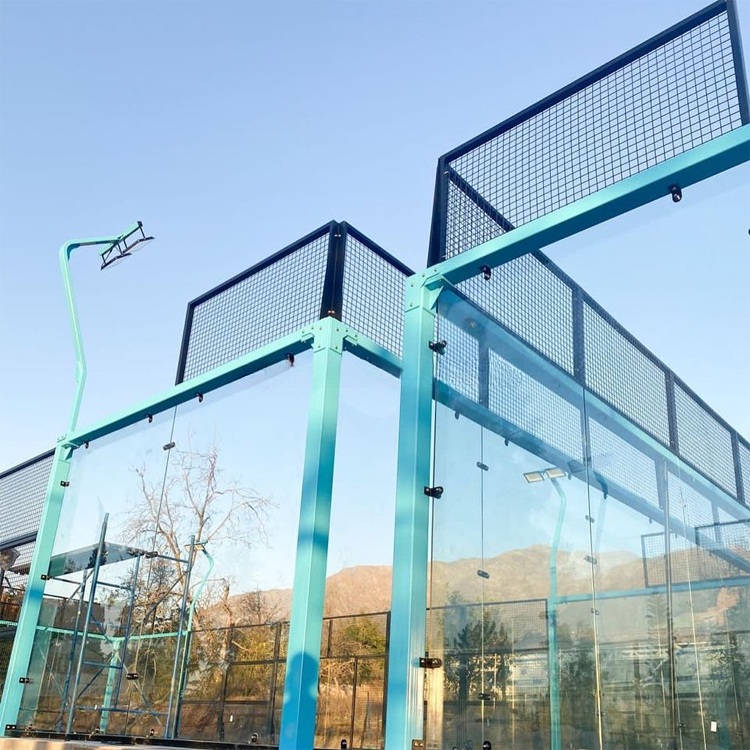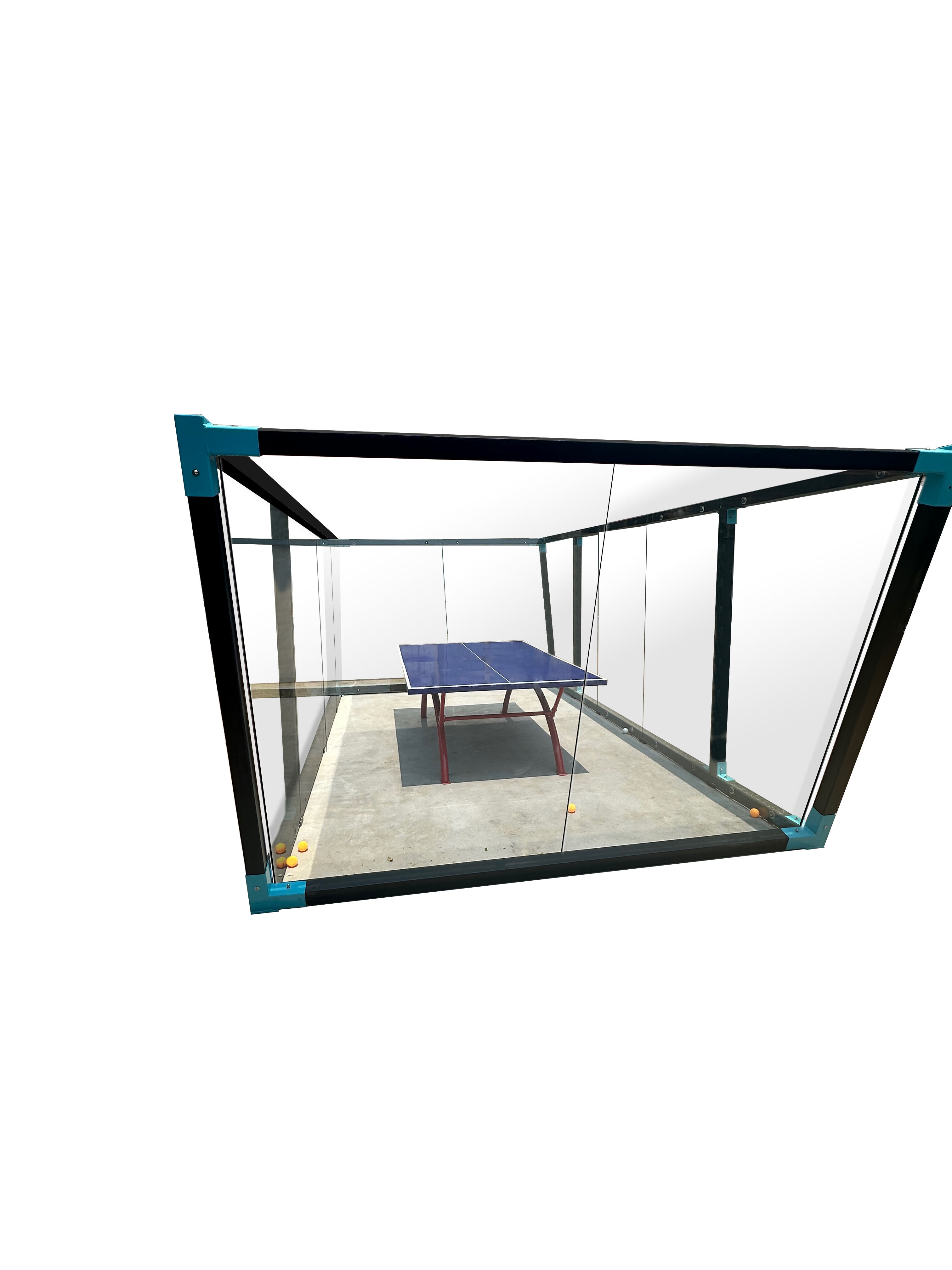The construction of padel tennis courts requires careful consideration of materials that can withstand intensive gameplay, weather conditions, and long-term use. Professional padel facilities depend on high-quality materials to ensure player safety, optimal performance, and minimal maintenance costs over time. Understanding which materials deliver exceptional durability helps facility owners make informed decisions that protect their investment while providing superior playing experiences for athletes and recreational players alike.

Essential Structural Framework Materials
Hot-Dip Galvanized Steel Components
Hot-dip galvanized steel represents the gold standard for padel court structural frameworks due to its exceptional corrosion resistance and structural integrity. This material undergoes a specialized coating process where steel components are immersed in molten zinc, creating a metallurgical bond that provides decades of protection against rust, oxidation, and environmental degradation. The galvanization process ensures that even minor scratches or surface damage do not compromise the underlying steel structure.
Professional installations utilize galvanized steel posts, beams, and connection hardware that can withstand extreme weather conditions, from intense UV radiation to heavy rainfall and temperature fluctuations. The material's strength-to-weight ratio makes it ideal for supporting glass panels, mesh systems, and lighting equipment without compromising structural stability. Quality galvanized steel components typically carry warranties of 15-25 years, reflecting their proven durability in outdoor sports facility applications.
Aluminum Alloy Alternatives
High-grade aluminum alloys offer another durable option for padel court construction, particularly in coastal environments where salt exposure poses additional corrosion challenges. Marine-grade aluminum provides excellent resistance to saltwater corrosion while maintaining lighter weight compared to steel alternatives. The material requires minimal maintenance and develops a protective oxide layer that enhances its longevity over time.
Aluminum frameworks excel in applications requiring frequent assembly and disassembly, such as temporary tournament installations or modular court systems. The material's thermal expansion properties must be carefully considered during design and installation to prevent stress-related failures. Premium aluminum alloy systems can deliver 20-30 years of reliable service when properly engineered and installed according to manufacturer specifications.
Court Surface Materials for Optimal Performance
Artificial Turf Systems
Modern artificial turf designed specifically for padel tennis court materials incorporates advanced polymer fibers that resist wear, UV degradation, and weather-related damage. High-quality synthetic turf systems feature monofilament or fibrillated fibers manufactured from polyethylene or polypropylene materials that maintain consistent playing characteristics throughout their lifespan. These materials undergo rigorous testing for durability, ball bounce consistency, and player safety standards.
The backing systems of professional-grade artificial turf utilize multiple layers of protective materials, including latex coatings, polyurethane barriers, and drainage fabrics that prevent moisture accumulation and extend surface life. Sand infill systems work in conjunction with synthetic fibers to provide appropriate ball speed, bounce height, and player traction. Premium artificial turf installations typically provide 8-12 years of optimal performance when properly maintained and periodically refreshed with new infill materials.
Concrete Foundation Requirements
The concrete foundation serves as the critical base layer that determines long-term court stability and performance consistency. High-strength concrete mixes incorporating specialized additives for freeze-thaw resistance, crack prevention, and moisture control ensure decades of reliable service. Professional installations utilize concrete with minimum compressive strengths of 3500-4000 PSI, reinforced with steel rebar or fiber mesh systems to prevent settlement-related damage.
Proper concrete curing, drainage integration, and expansion joint placement are essential for preventing premature deterioration and maintaining level playing surfaces. The concrete foundation must accommodate precise grading requirements, utility installations, and anchor point locations for court framework attachment. Quality concrete foundations with appropriate reinforcement and drainage systems can provide 30-50 years of service life with minimal maintenance requirements.
Enclosure and Safety Materials
Tempered Glass Panel Systems
Tempered glass panels provide the transparent barriers essential for padel gameplay while ensuring player safety and spectator visibility. These specialized glass panels undergo thermal treatment processes that increase strength by 4-5 times compared to standard glass, while creating safer breakage patterns in the unlikely event of impact damage. Professional-grade tempered glass meets international safety standards and incorporates UV-resistant coatings that prevent degradation over time.
The thickness specifications for padel court glass typically range from 10-12mm, providing optimal balance between strength, weight, and cost considerations. Installation systems utilize specialized hardware and gasket materials designed to accommodate thermal expansion while maintaining weather-tight seals. Premium tempered glass installations can provide 15-20 years of service with minimal maintenance beyond periodic cleaning and hardware inspection.
Metal Mesh Barrier Systems
High-tensile metal mesh materials complete the padel court enclosure system, providing ball containment and additional safety barriers above glass panel heights. Professional mesh systems utilize galvanized or powder-coated steel wire with precise opening dimensions that prevent ball passage while maintaining visibility and airflow. The mesh materials must resist stretching, corrosion, and impact damage from ball strikes and weather exposure.
Installation methods for metal mesh systems require tension adjustment capabilities and secure attachment points that distribute loads evenly across supporting structures. Quality mesh materials undergo coating processes that provide 10-15 years of protection against corrosion and UV degradation. Regular inspection and maintenance of mesh tension and attachment hardware ensure continued safety and performance throughout the system's service life.
Specialized Components and Accessories
LED Lighting Systems
Modern LED lighting systems designed for padel courts incorporate weather-resistant housings, impact-resistant lenses, and energy-efficient components that provide decades of reliable illumination. Professional lighting installations utilize aluminum or composite housings with IP65 or higher protection ratings against moisture, dust, and environmental contamination. The LED components themselves offer 50,000+ hour lifespans with minimal light output degradation over time.
Advanced LED systems include programmable controls, dimming capabilities, and energy management features that reduce operating costs while maintaining optimal lighting levels for tournament and recreational play. The mounting hardware and electrical connections must withstand vibration, thermal cycling, and weather exposure without compromising safety or performance. Quality LED lighting systems typically provide 15-20 years of service with minimal maintenance requirements beyond periodic cleaning and component inspection.
Drainage and Water Management
Effective drainage systems incorporate corrosion-resistant materials including PVC, HDPE, or cast iron components designed for long-term underground installation. Professional drainage designs utilize multiple collection points, adequate pipe sizing, and proper slope calculations to ensure rapid water removal during heavy rainfall events. The materials must resist root intrusion, soil settlement, and freeze-thaw damage in applicable climate zones.
Surface drainage integration includes channel drains, catch basins, and permeable materials that direct water away from playing surfaces while maintaining structural integrity. Quality drainage systems require minimal maintenance when properly designed and installed with appropriate materials. Professional installations typically provide 25-40 years of effective water management with periodic inspection and cleaning of collection components.
FAQ
How long do high-quality padel tennis court materials typically last?
Premium padel tennis court materials are engineered for different lifespans depending on their function and exposure conditions. Galvanized steel frameworks typically provide 15-25 years of service, while concrete foundations can last 30-50 years with proper installation. Artificial turf surfaces generally require replacement every 8-12 years, and tempered glass panels can provide 15-20 years of reliable service. LED lighting systems offer 15-20 year lifespans, making them highly cost-effective long-term investments.
What factors most significantly impact material durability in padel courts?
Climate conditions, usage intensity, and maintenance practices are the primary factors affecting material longevity. UV exposure, temperature fluctuations, moisture levels, and salt air in coastal locations can accelerate material degradation if not properly addressed during material selection and installation. Regular maintenance, proper drainage, and adherence to manufacturer guidelines significantly extend material lifespans and maintain optimal performance characteristics throughout the facility's operational life.
Are there sustainable material options available for padel court construction?
Modern padel tennis court materials increasingly incorporate sustainable manufacturing processes and recyclable components. Aluminum frameworks are highly recyclable, while advanced artificial turf systems now utilize recycled plastic content and improved end-of-life recycling programs. LED lighting systems reduce energy consumption by 60-80% compared to traditional lighting, and many manufacturers offer take-back programs for component recycling at end of service life.
How do material choices affect long-term maintenance costs?
Premium material investments typically reduce long-term maintenance expenses through enhanced durability, weather resistance, and extended service intervals. High-quality galvanized steel requires minimal maintenance compared to painted alternatives, while premium artificial turf systems maintain performance longer with less frequent infill replacement. LED lighting systems eliminate lamp replacement costs for 15+ years while reducing electrical consumption, making them highly cost-effective despite higher initial investments.

